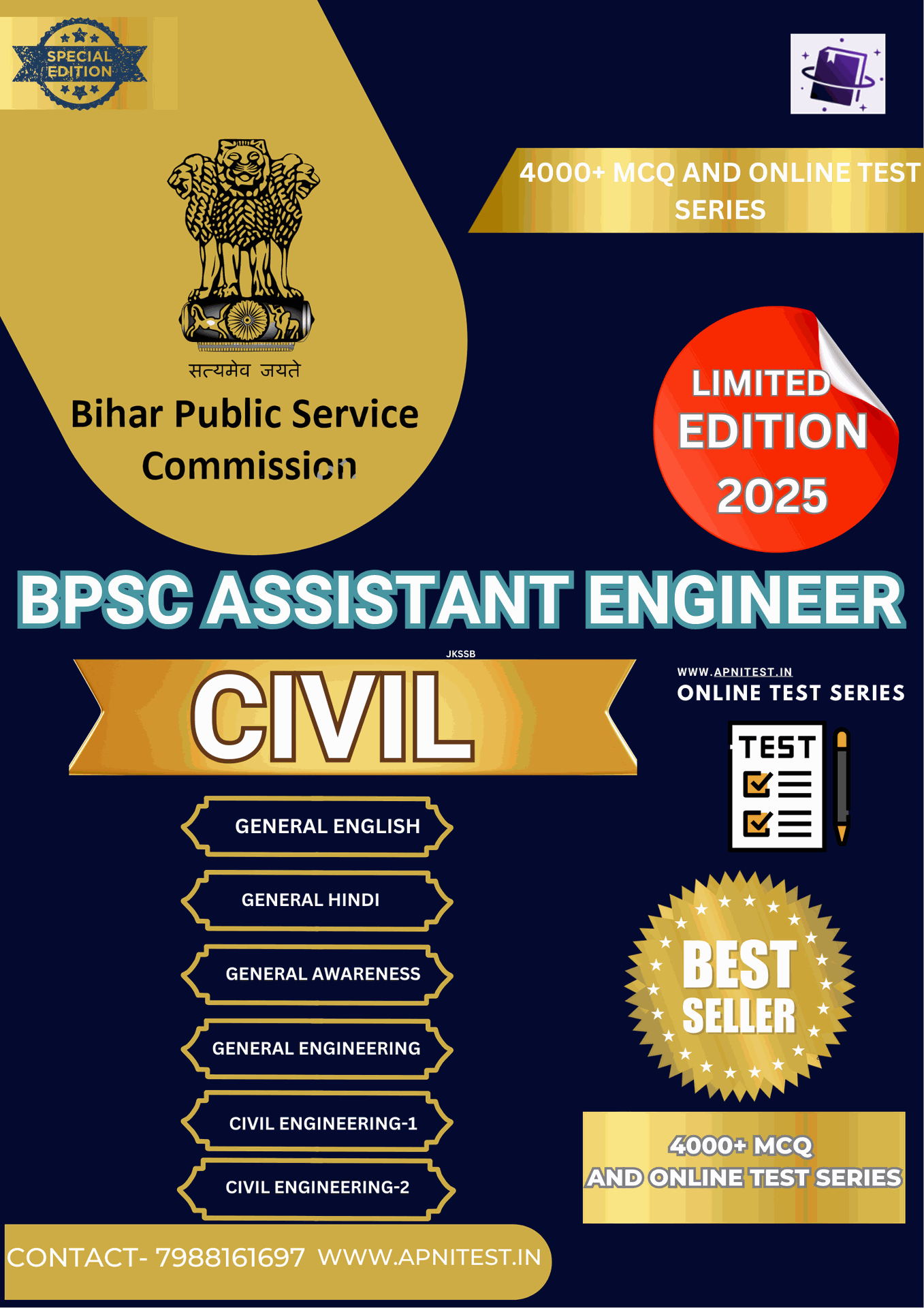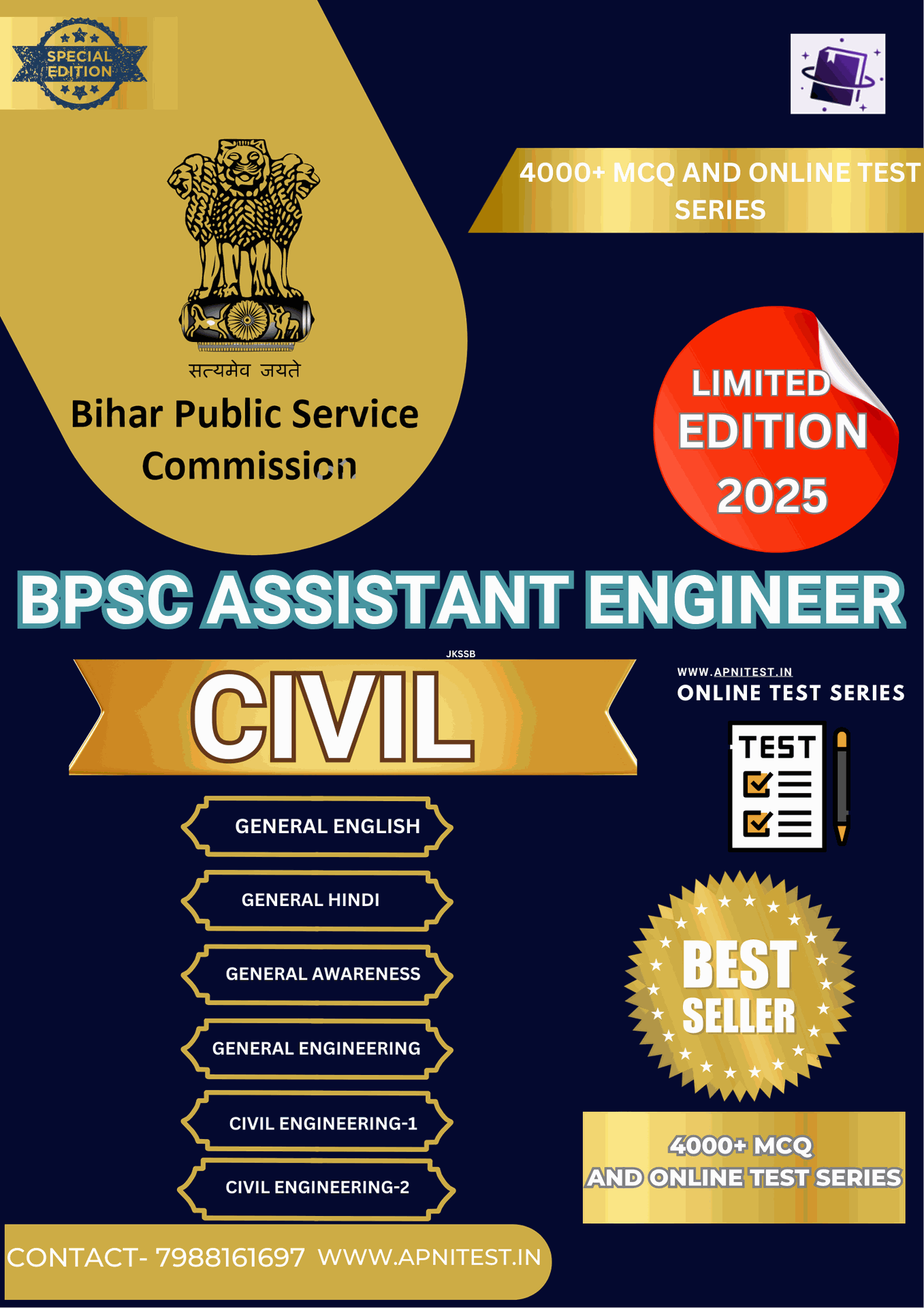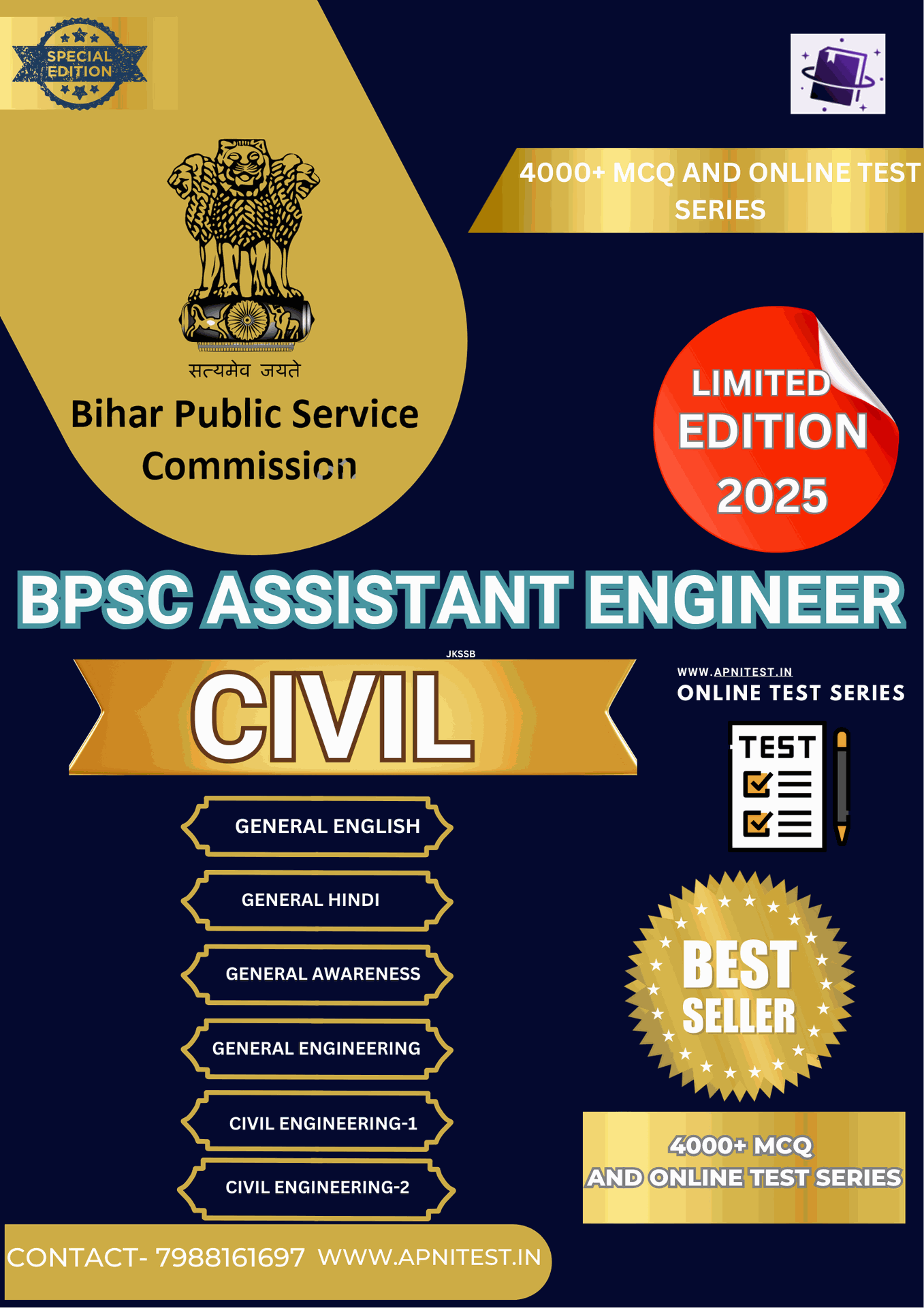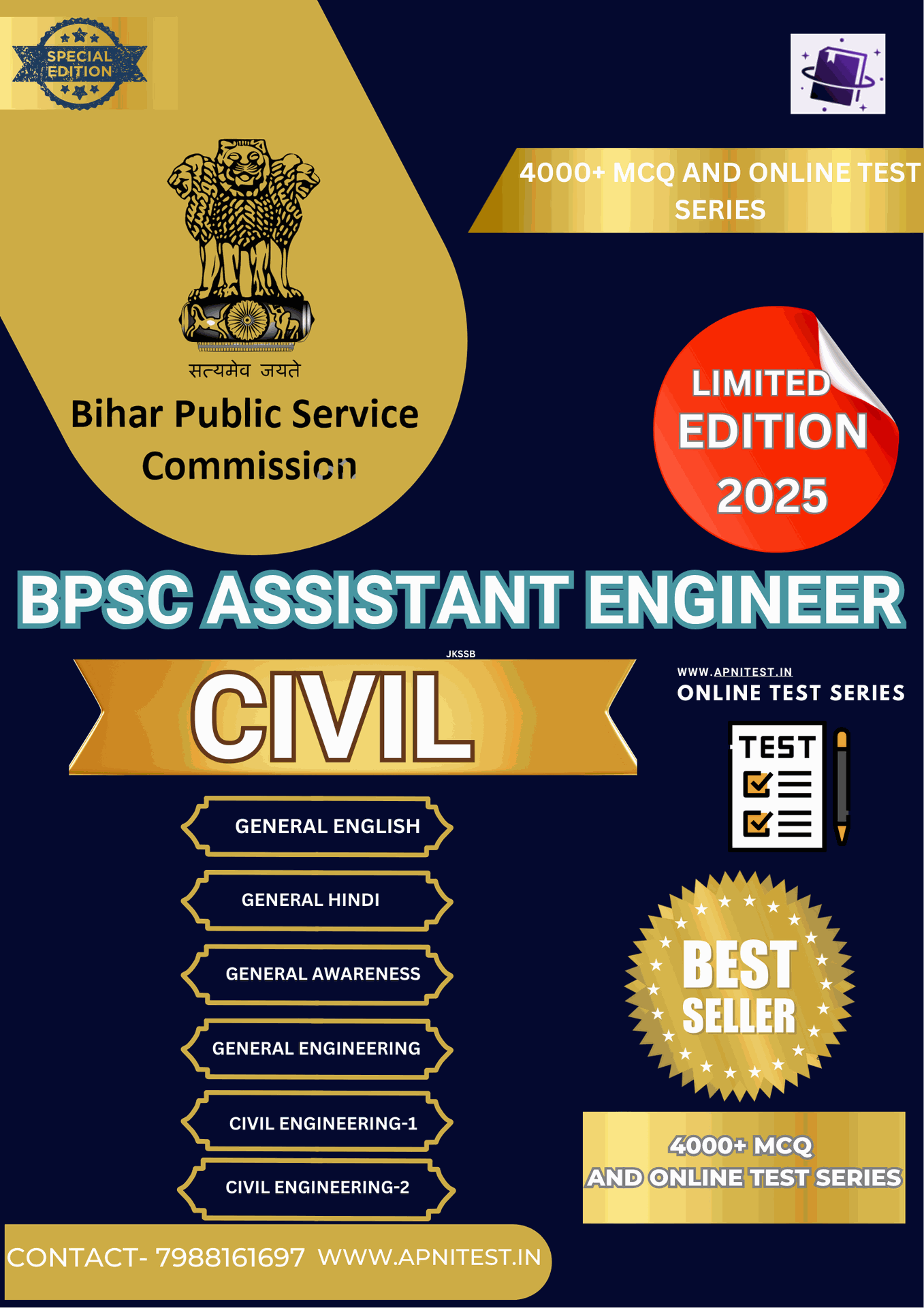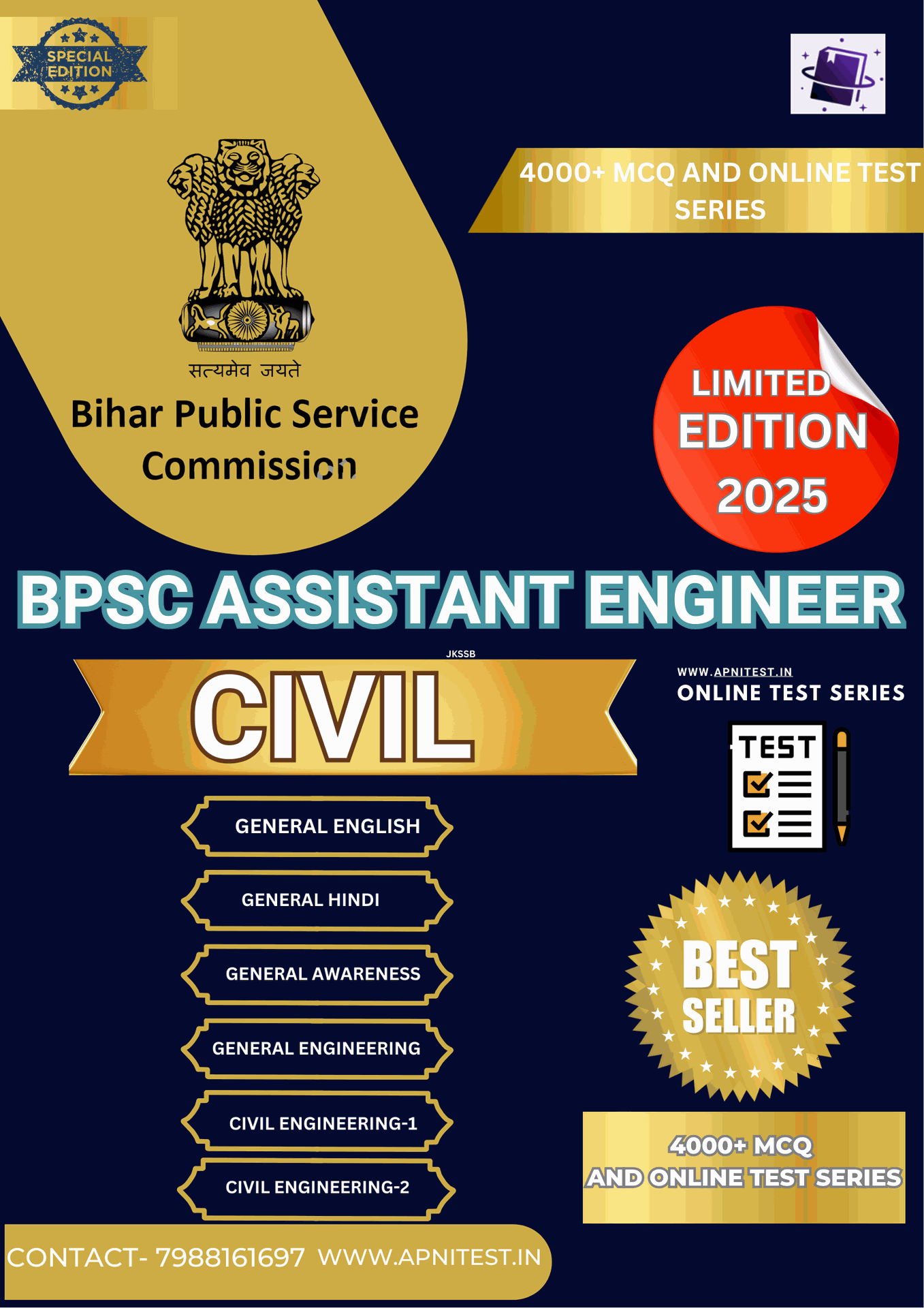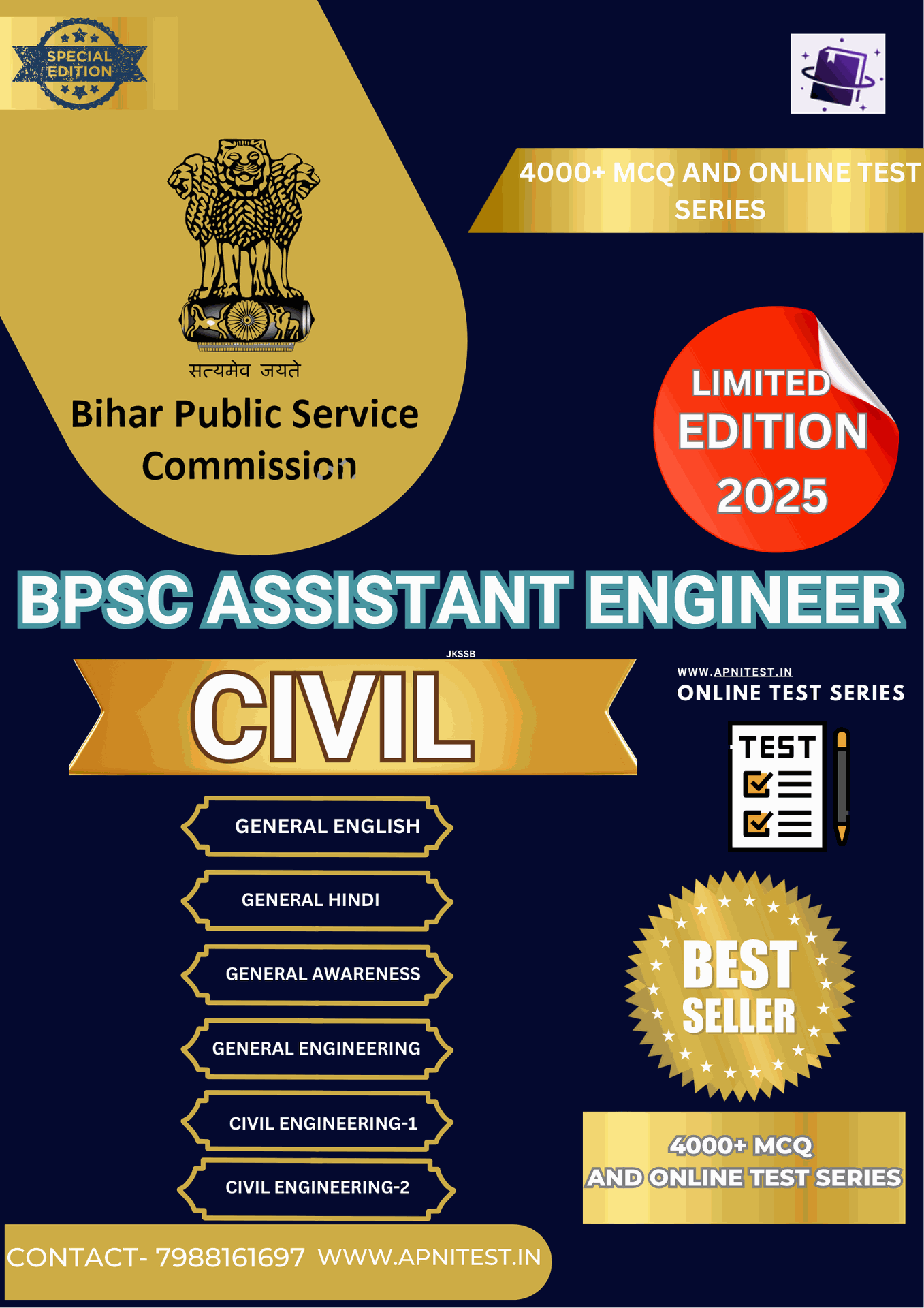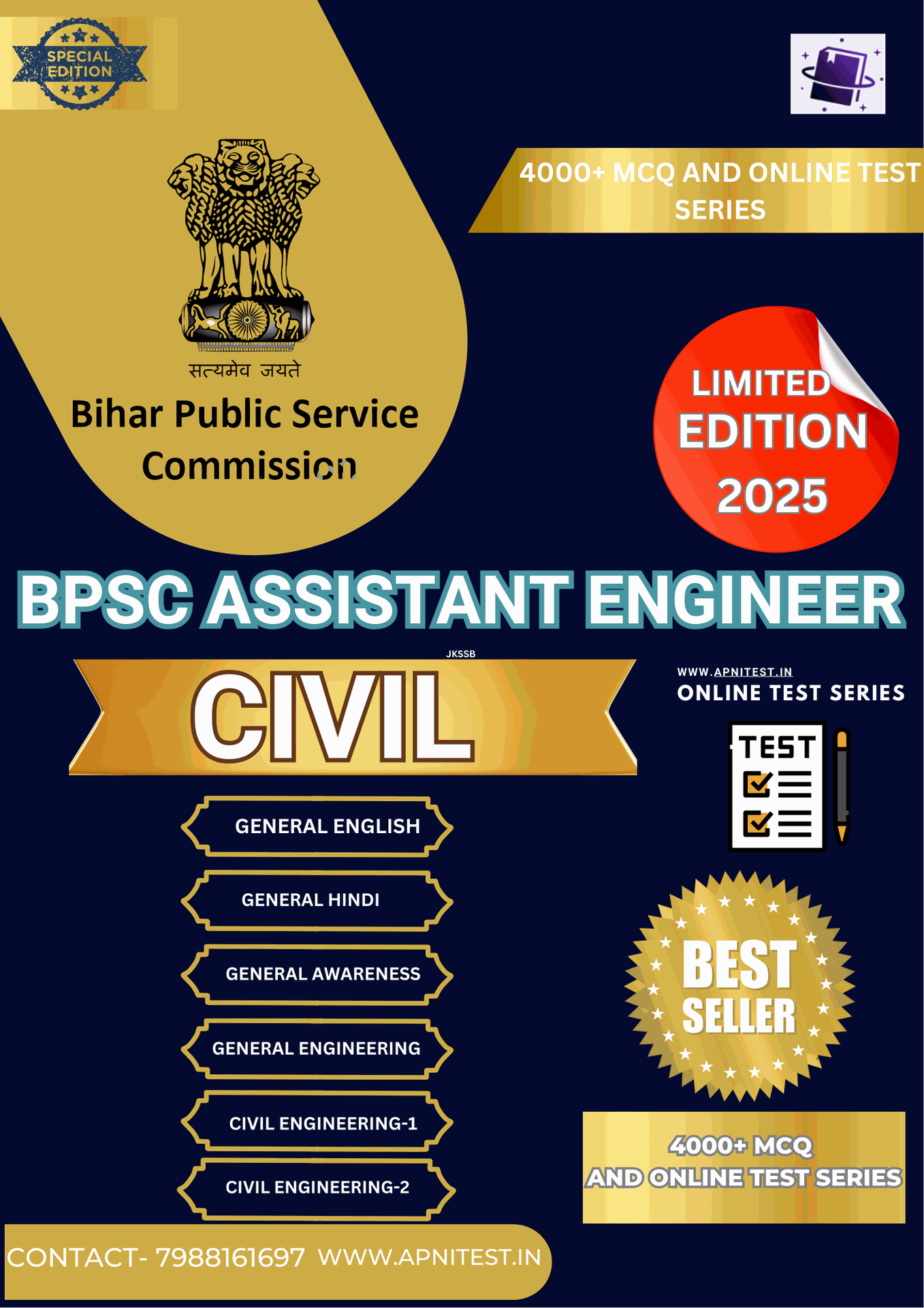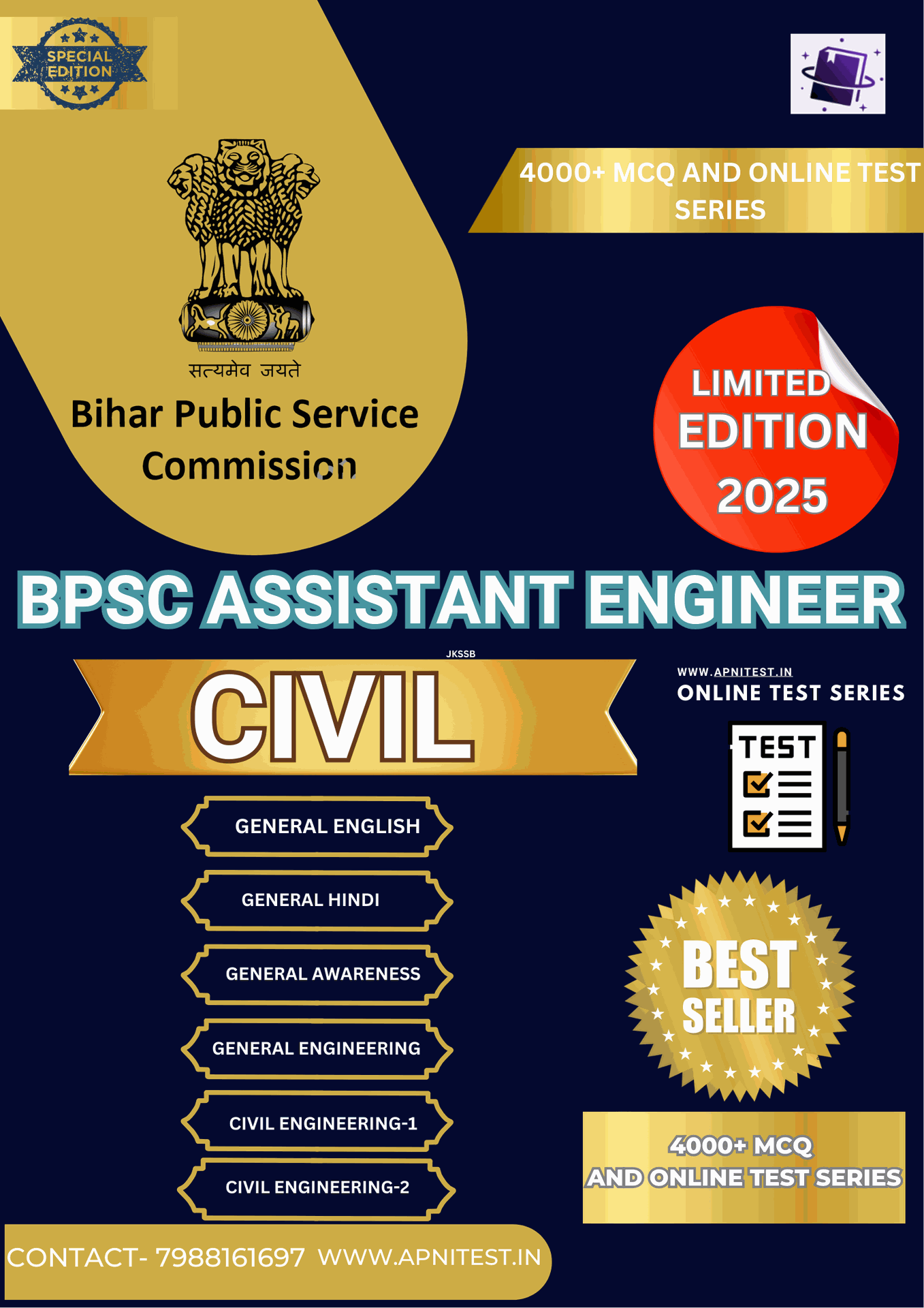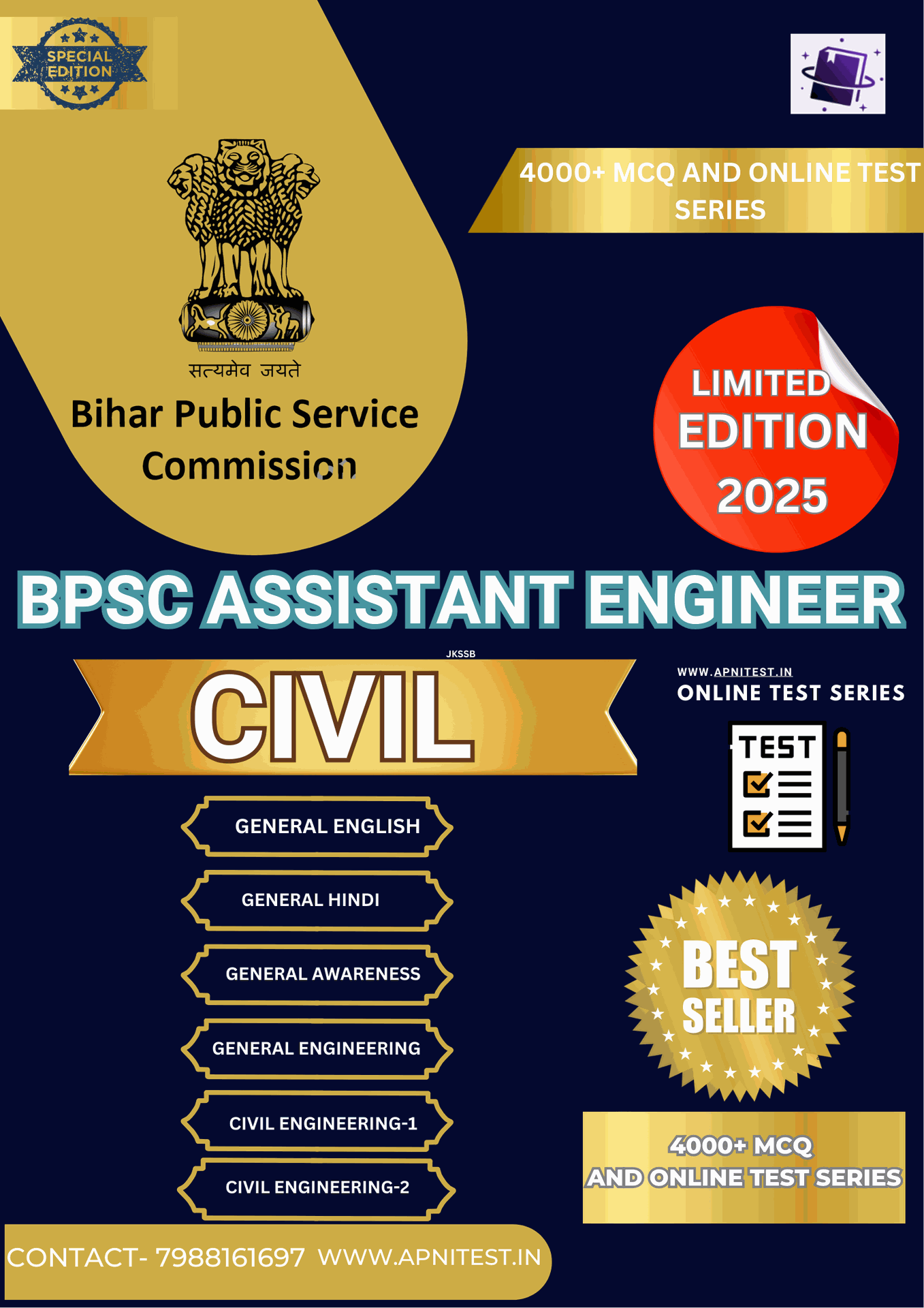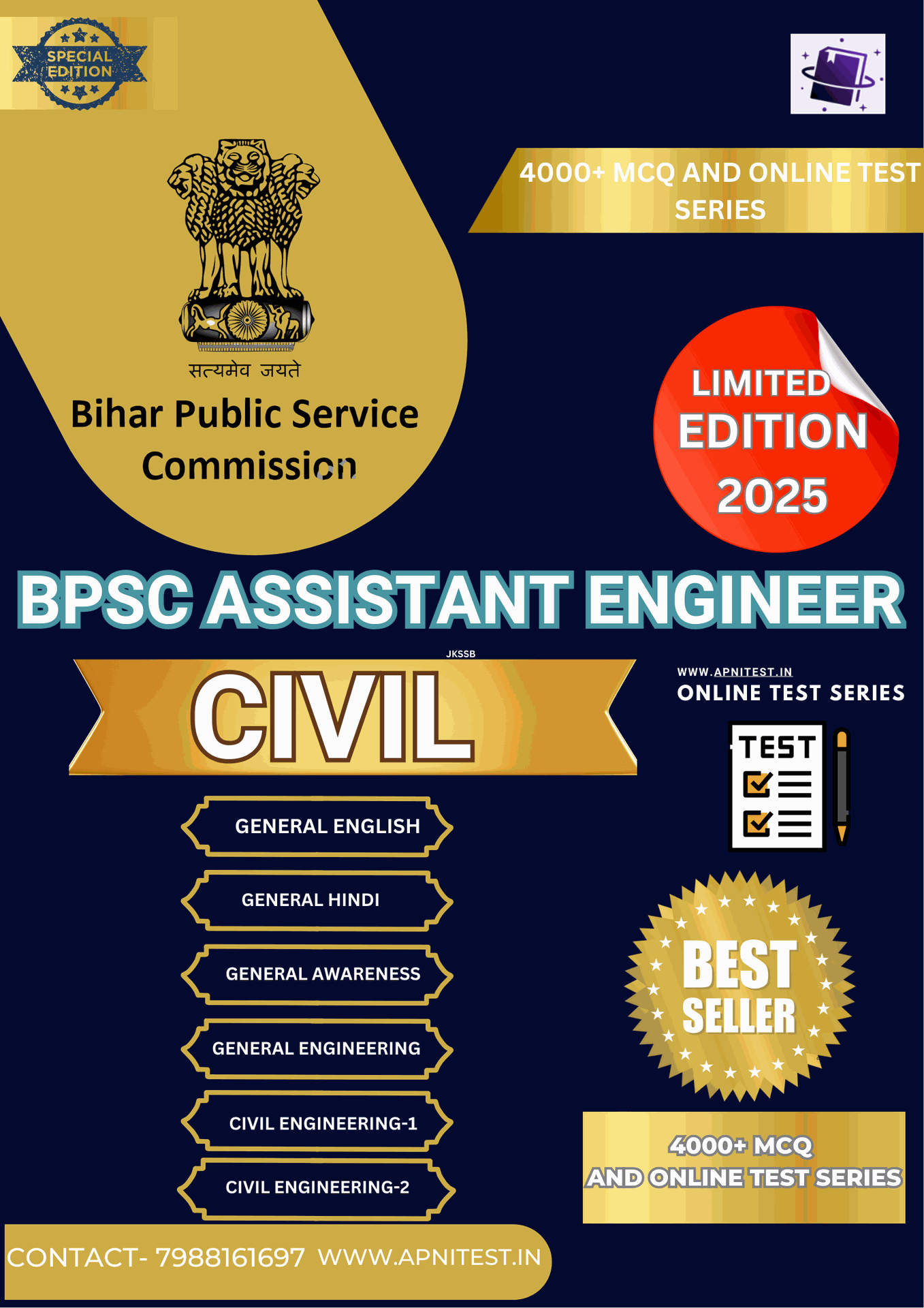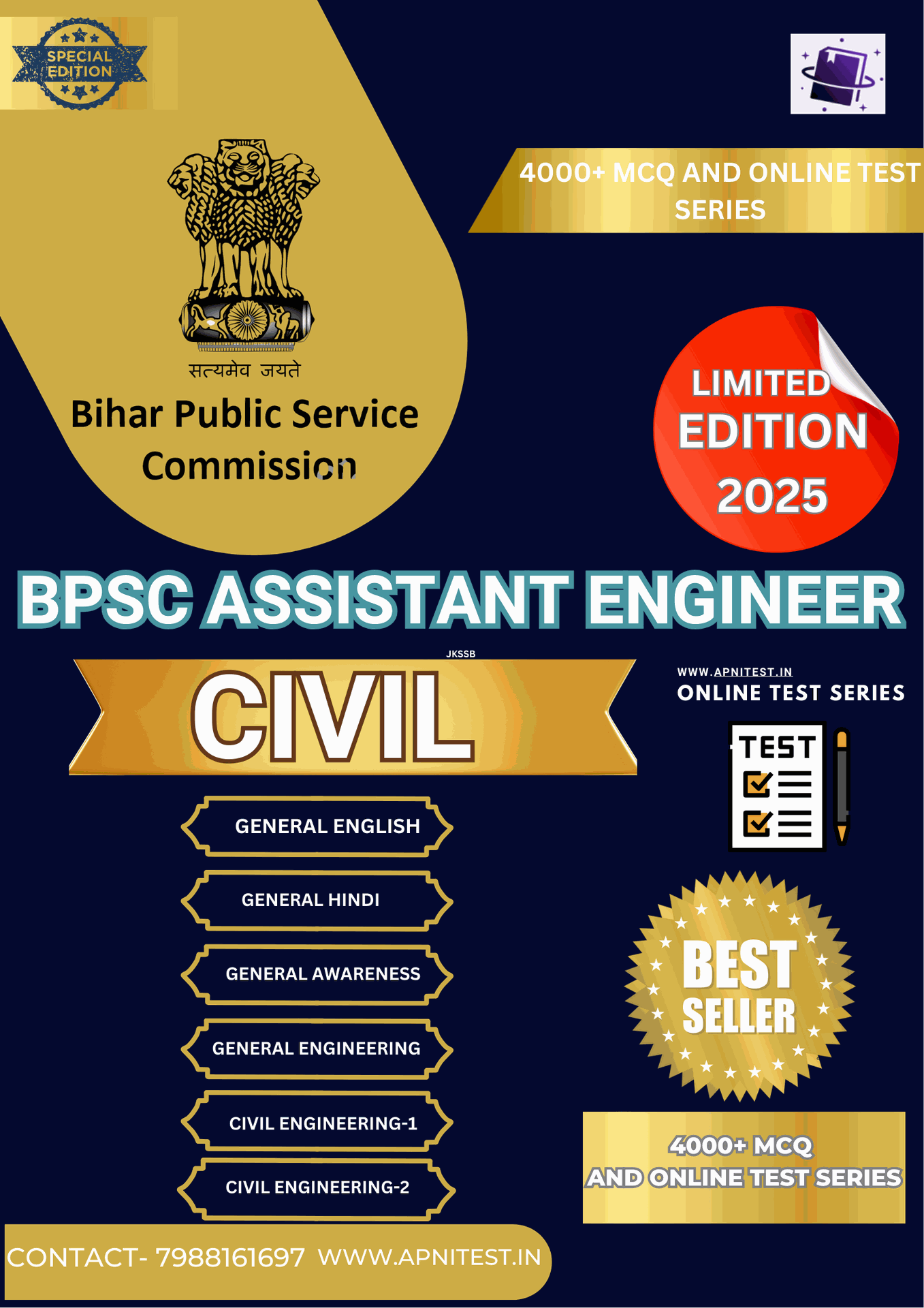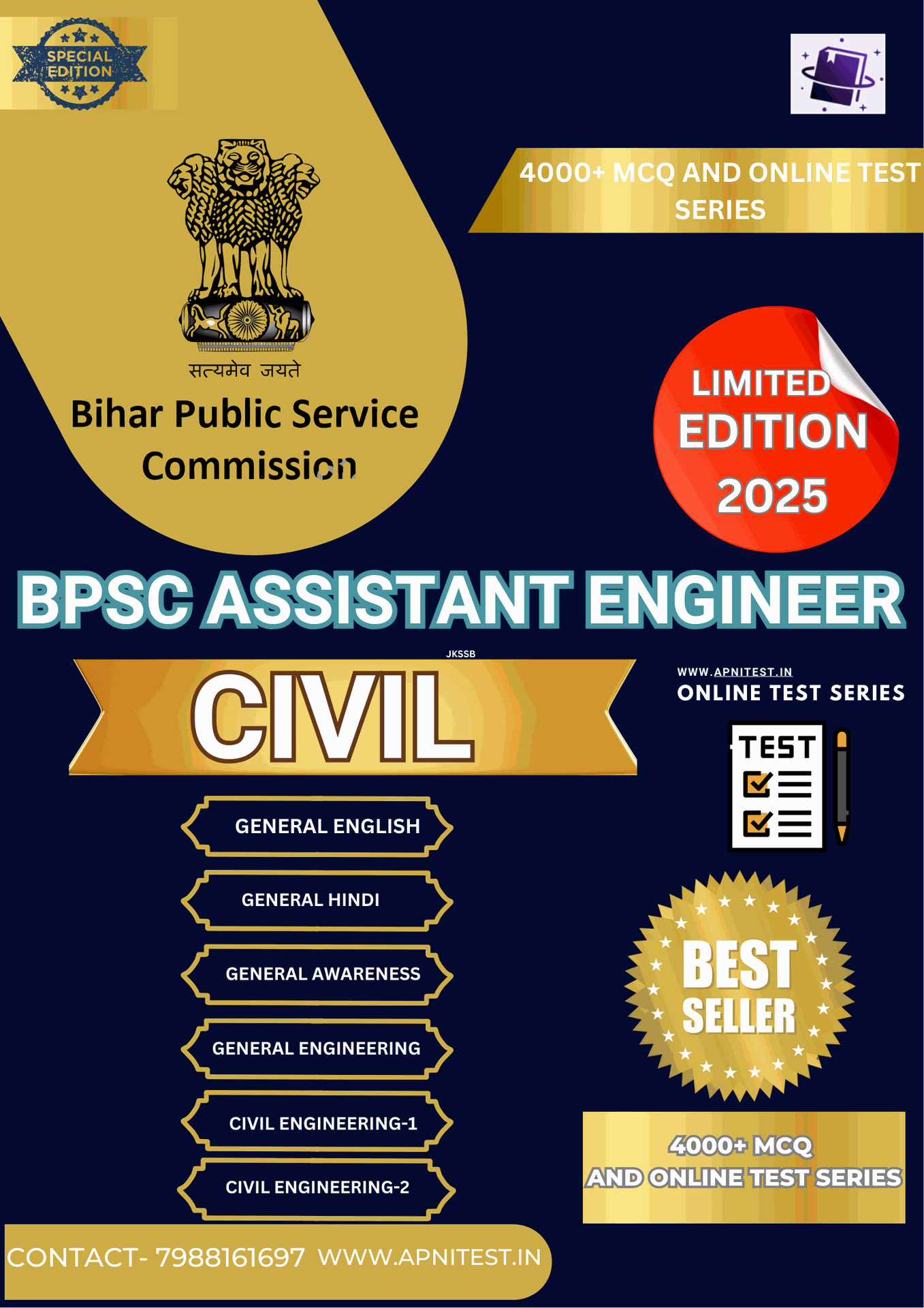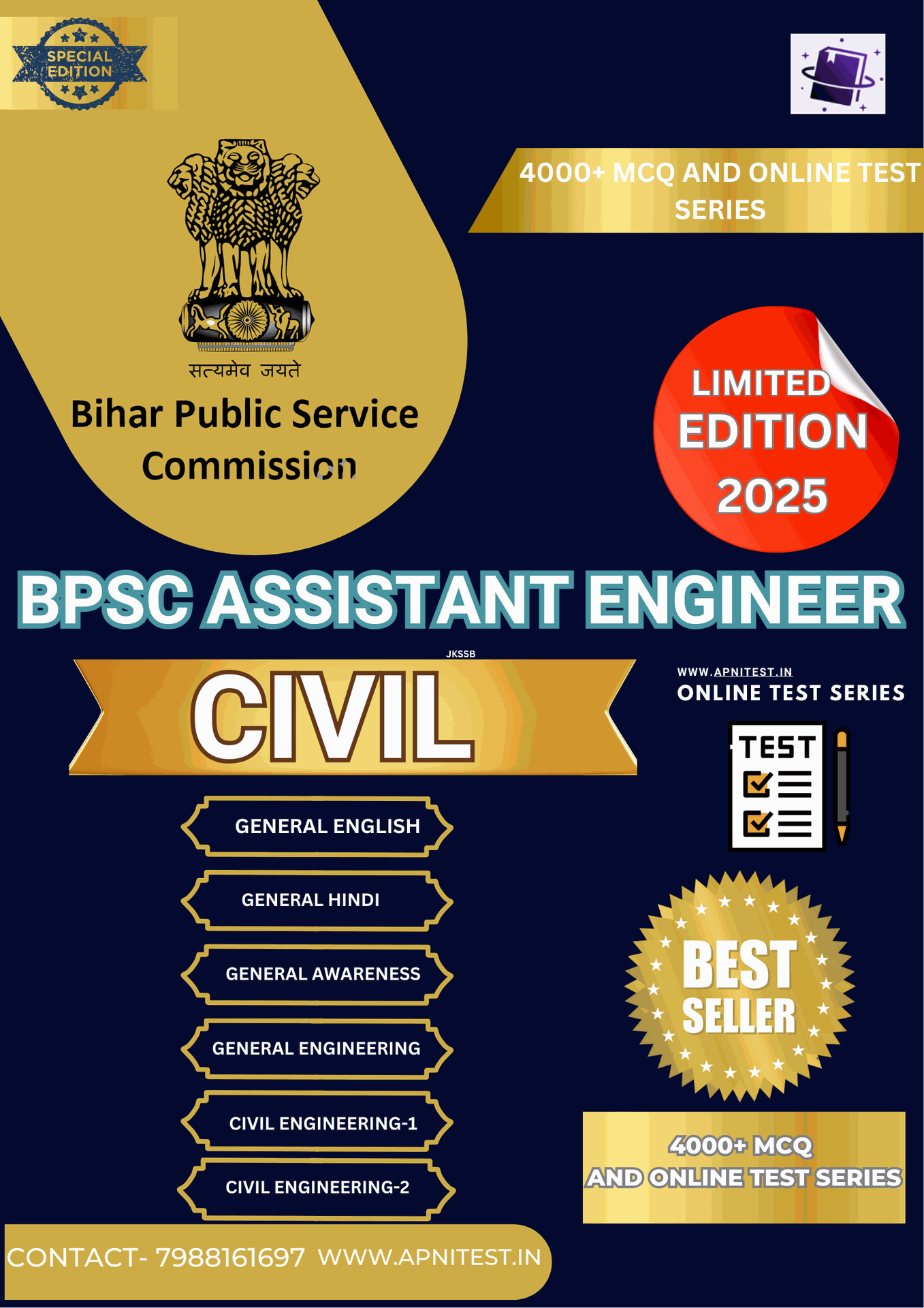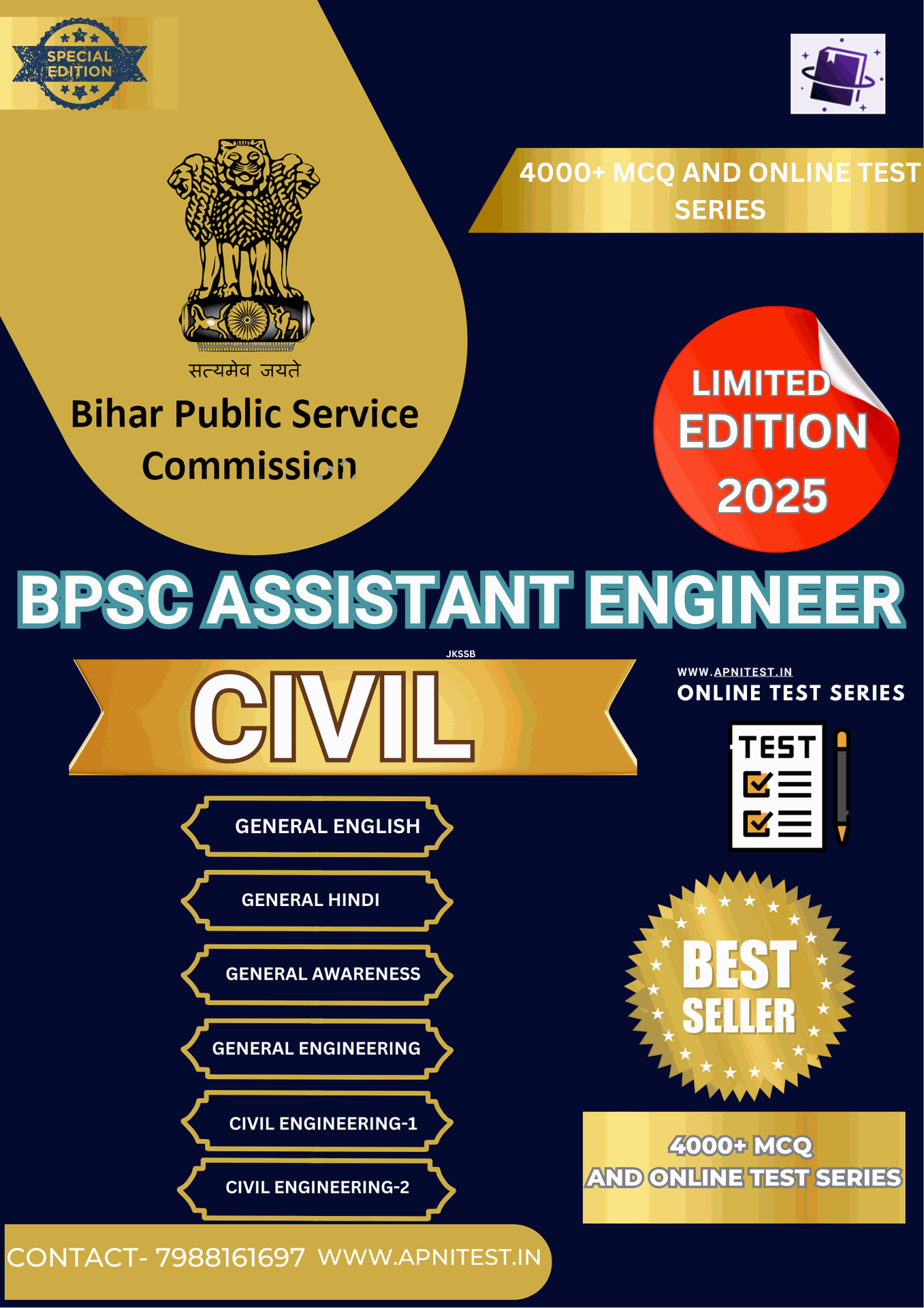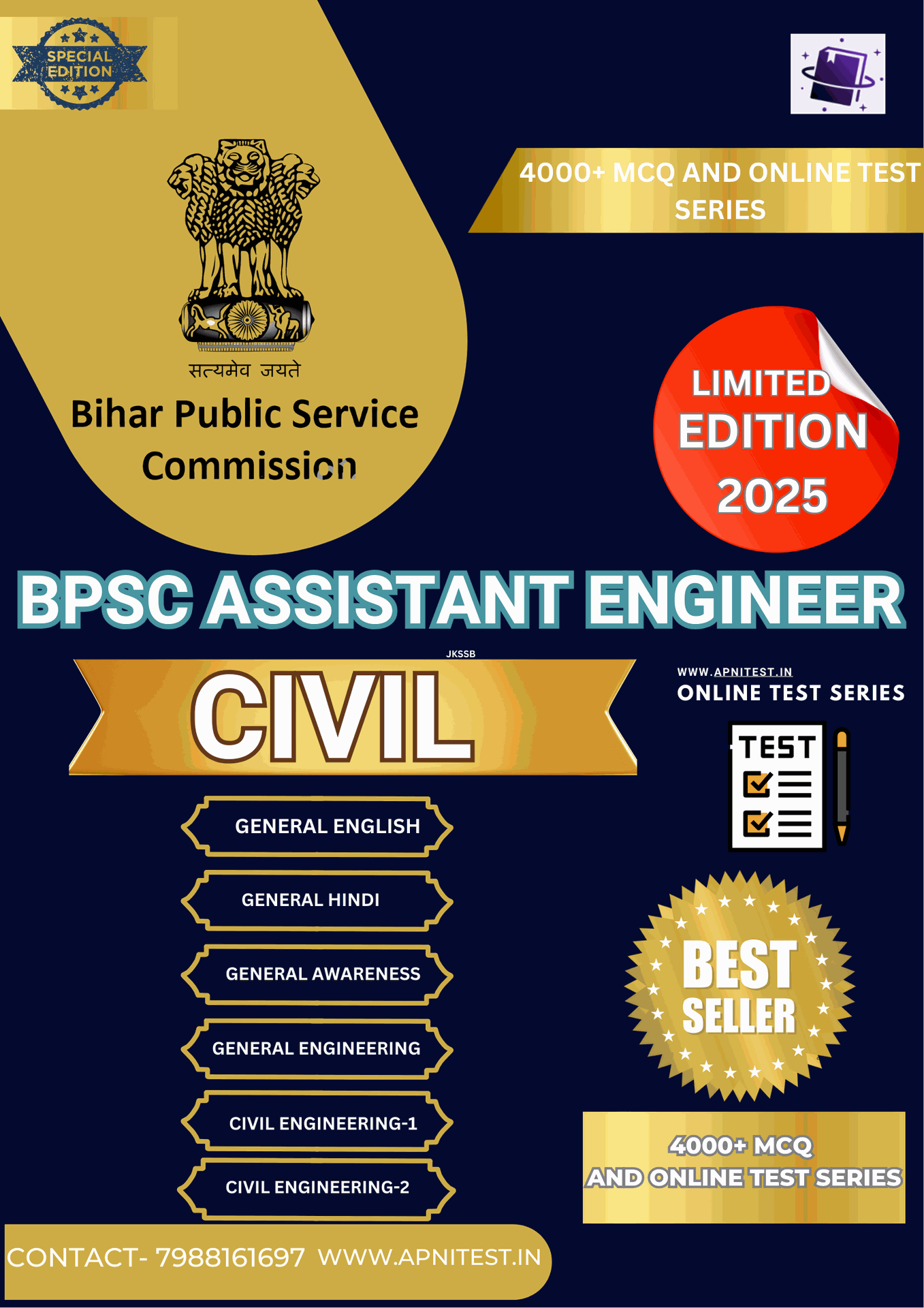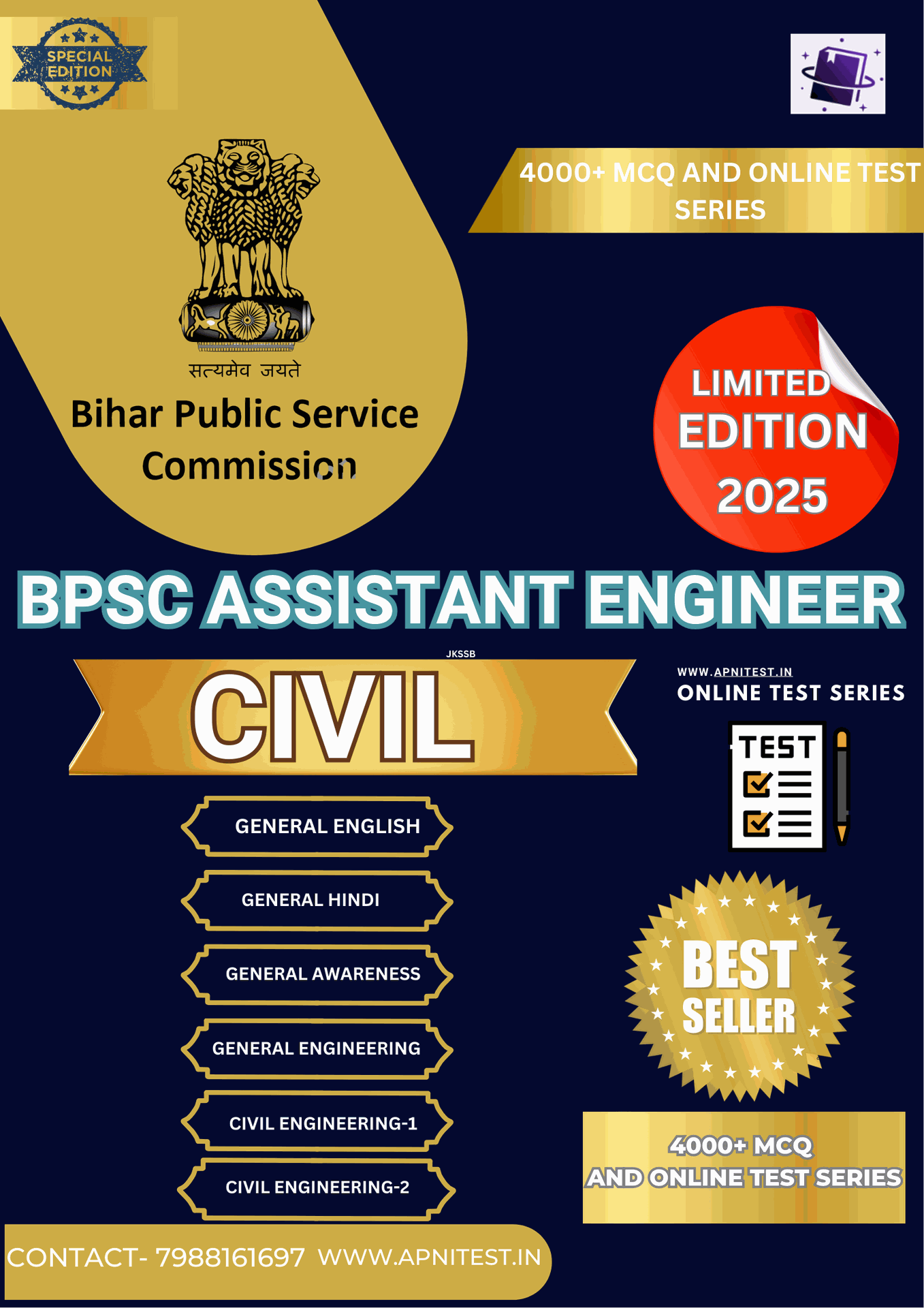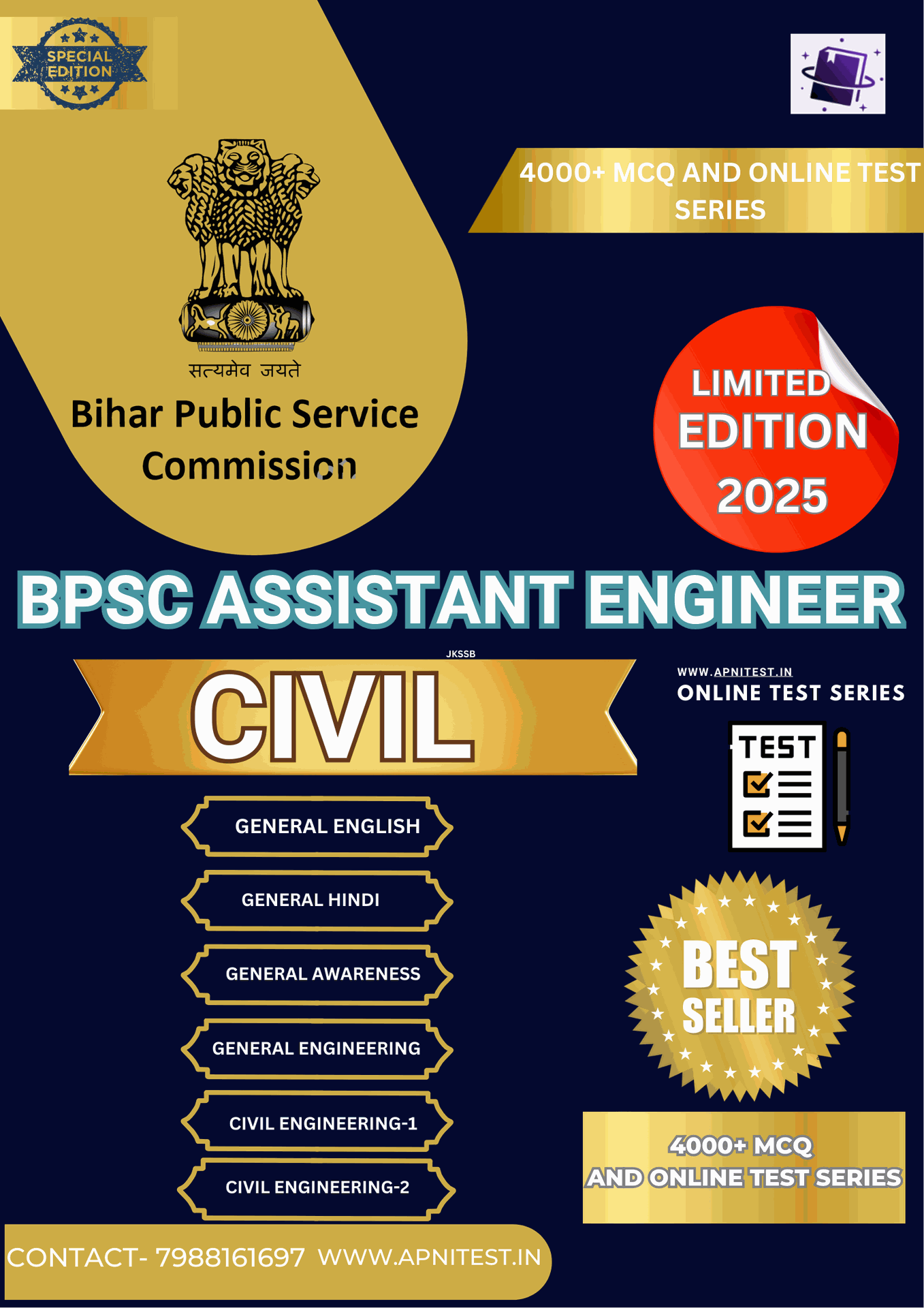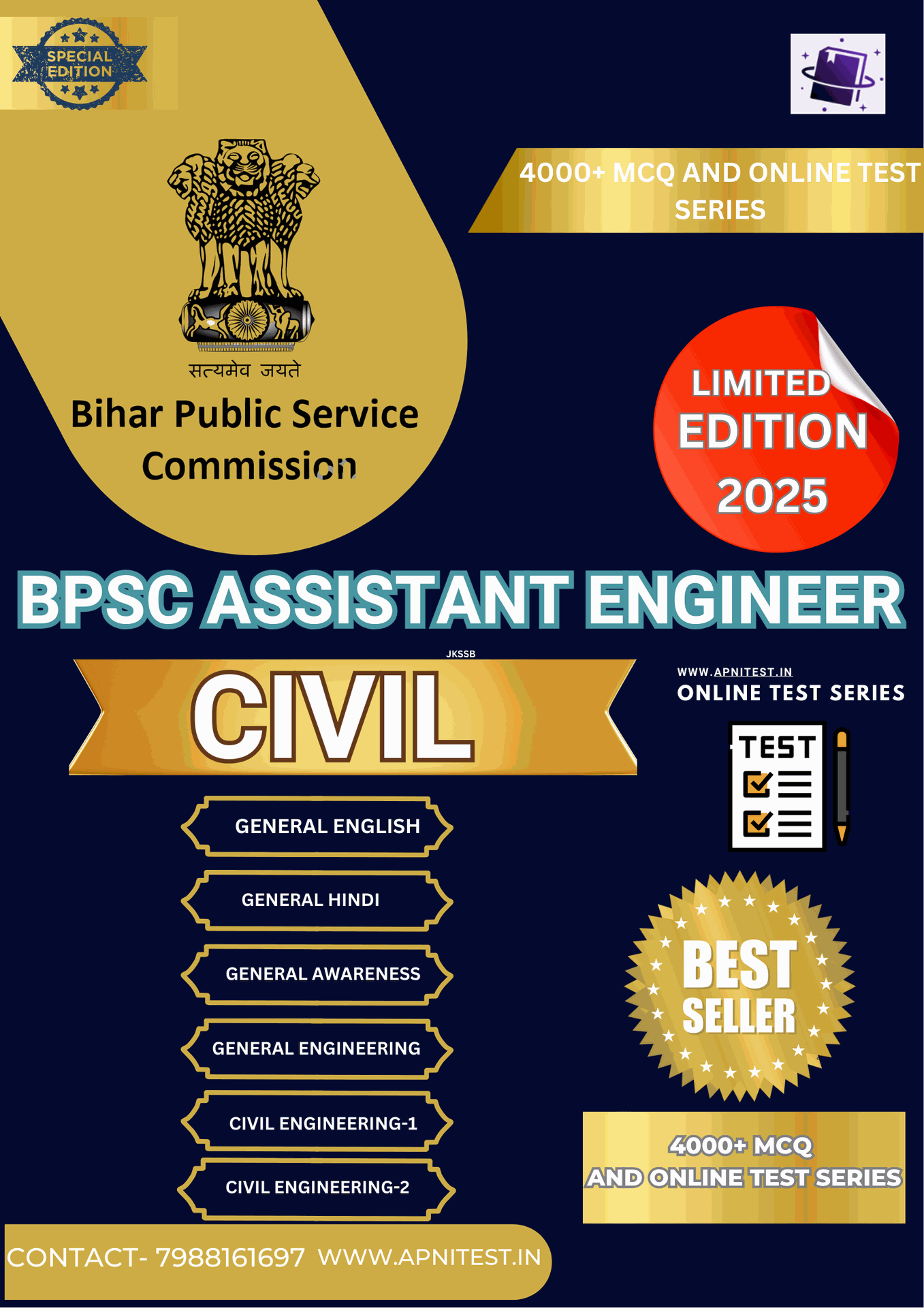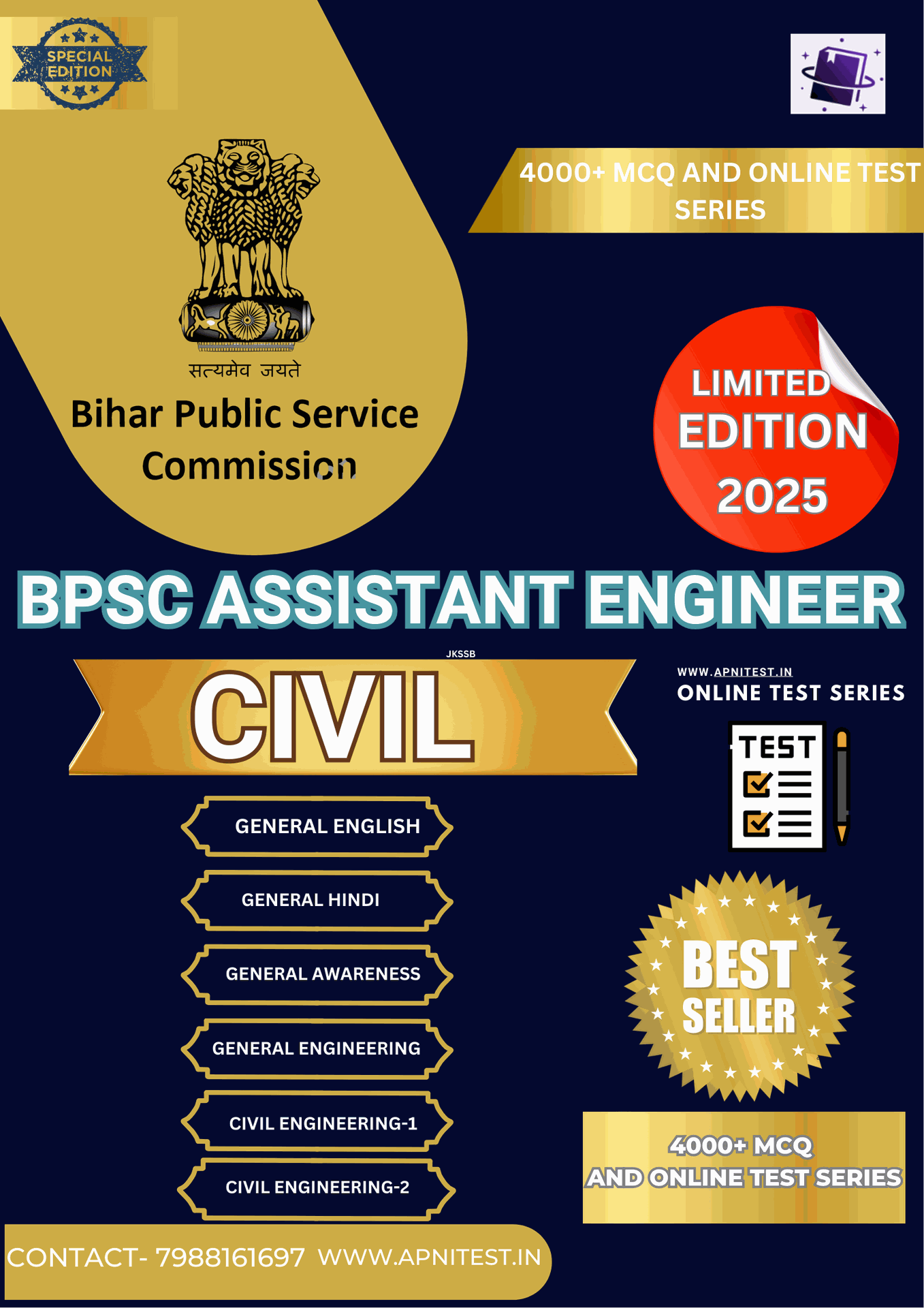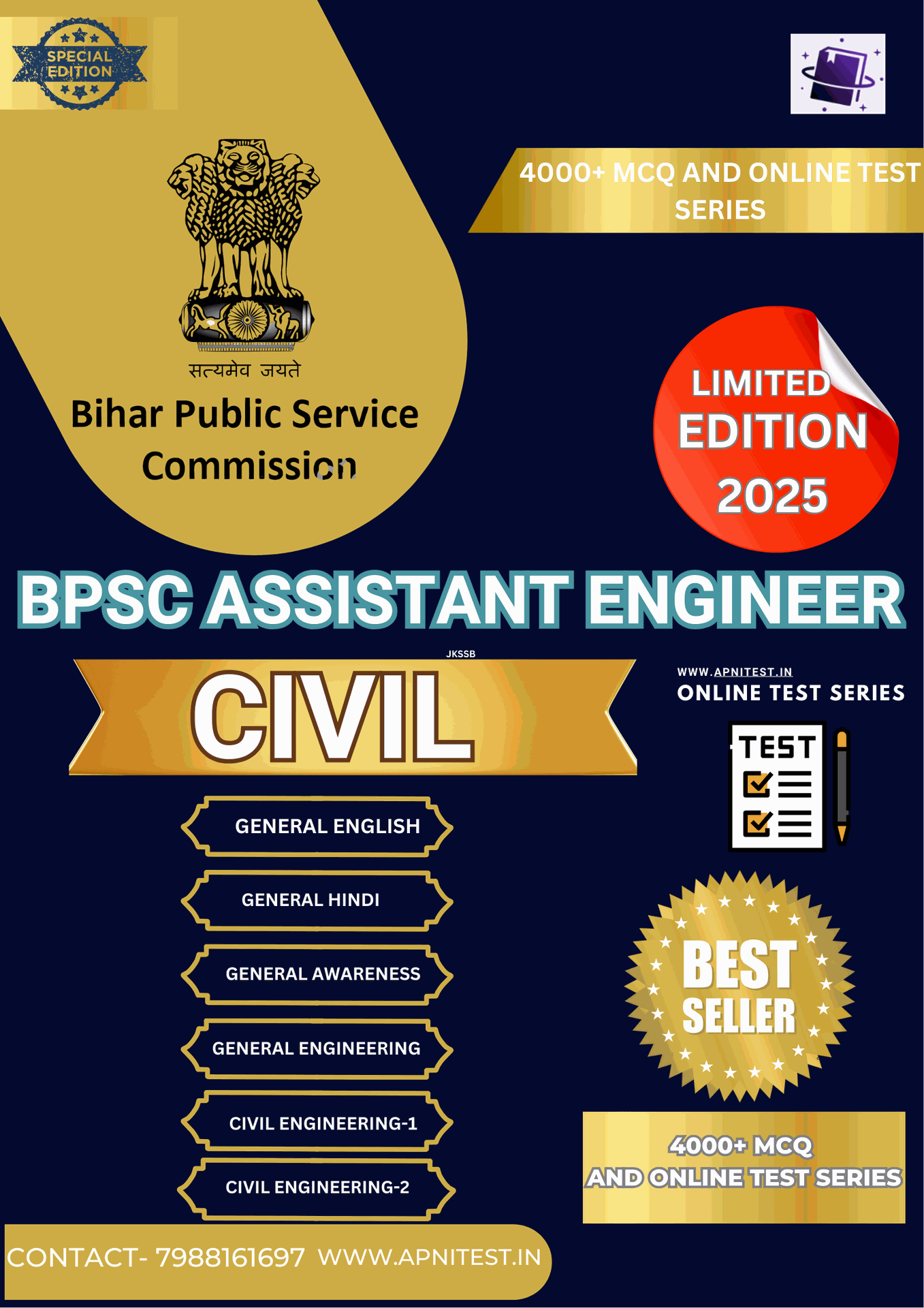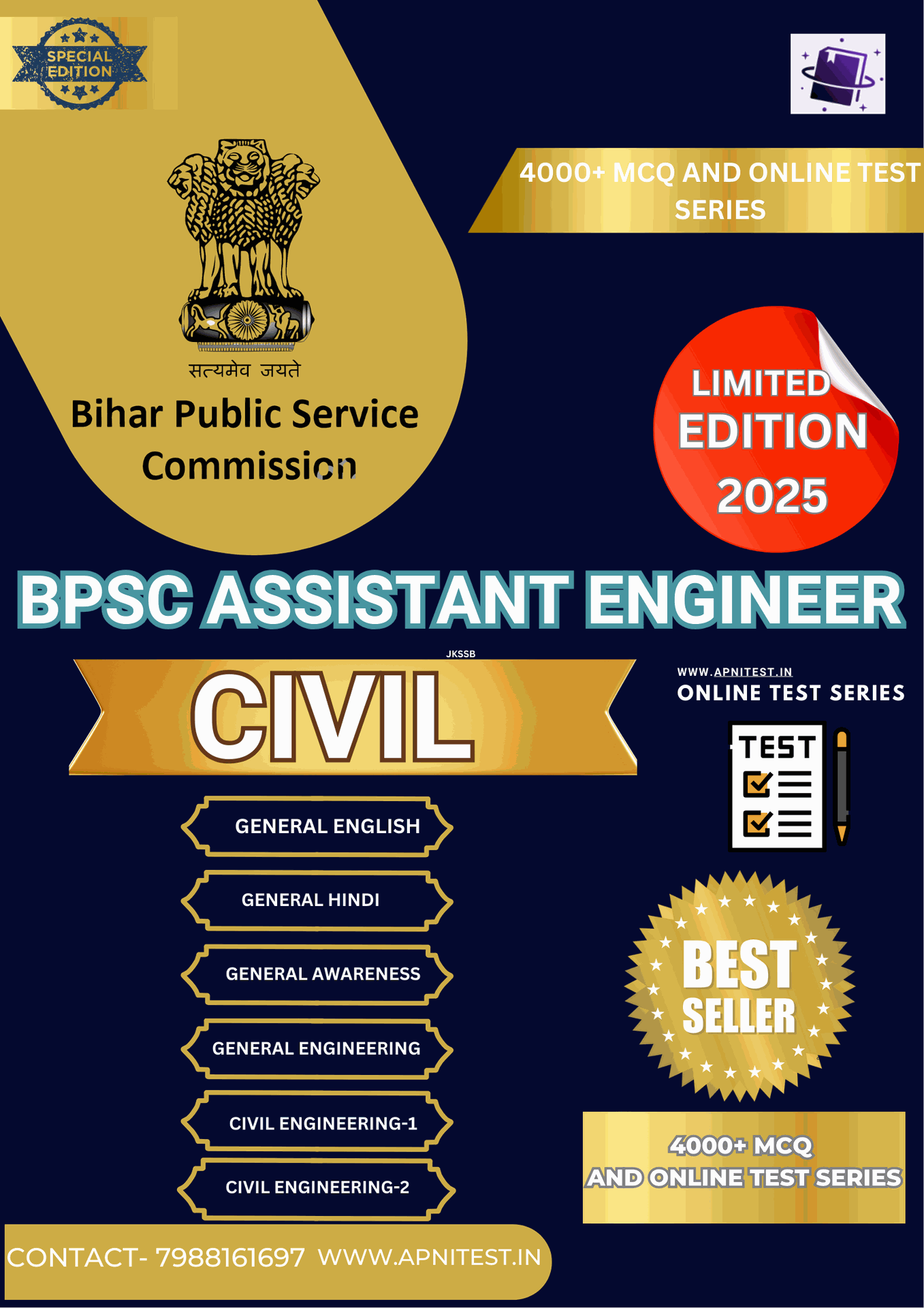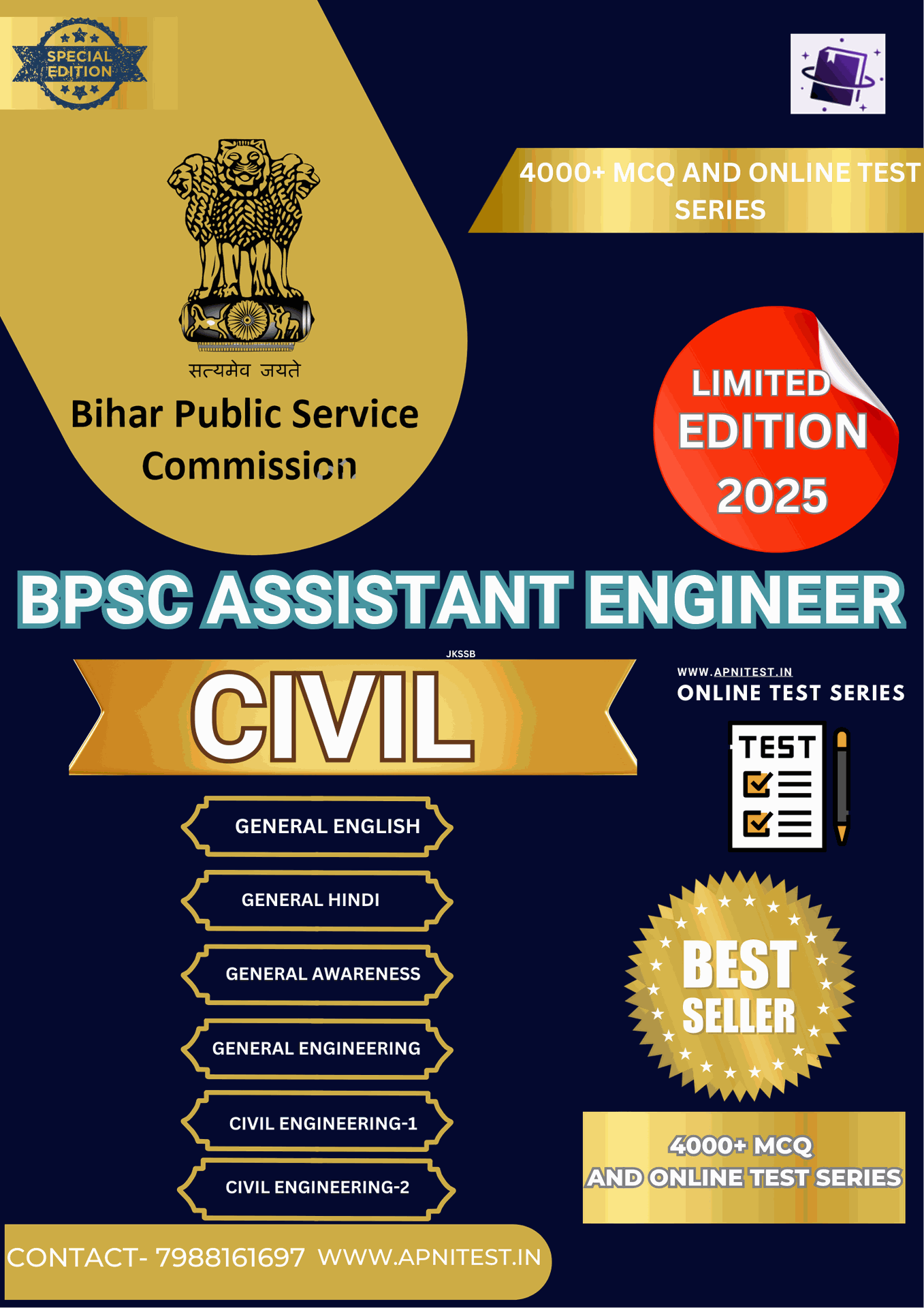BOOK BUY AND DETAIL LINK-https://www.apnitest.in/shop/bpsc-assistant-engineer-civil-engineering-book-and-test-series-448?search=bpsc
1. What is the primary goal of fixation in civil engineering?
- A) Stabilize the structure
- B) Increase the lifespan of the structure
- C) Ensure structural permanency
- D) Enhance structural flexibility
Answer: C) Ensure structural permanency
Analysis: Fixation aims to secure the structural components in place, contributing to the overall stability and permanency of the structure.
2. Which of the following materials is most commonly used for permanent fixation in construction?
- A) Wood
- B) Steel
- C) Plastic
- D) Rubber
Answer: B) Steel
Analysis: Steel is widely used due to its high strength, durability, and ability to support heavy loads, making it ideal for permanent structural fixation.
BOOK BUY AND DETAIL LINK-https://www.apnitest.in/shop/bpsc-assistant-engineer-civil-engineering-book-and-test-series-448?search=bpsc
3. What role does permanence play in the design of civil engineering structures?
- A) Minimizes cost
- B) Maximizes durability
- C) Reduces material usage
- D) Enhances design flexibility
Answer: B) Maximizes durability
Analysis: Permanence ensures that structures are durable and can withstand environmental and load conditions over time.
4. Which of the following is NOT a method to achieve fixation in civil engineering?
- A) Welding
- B) Bolting
- C) Gluing
- D) Painting
Answer: D) Painting
Analysis: Painting is used for protection, not for fixing components in place. Fixation is typically achieved through methods like welding, bolting, or gluing.
BOOK BUY AND DETAIL LINK-https://www.apnitest.in/shop/bpsc-assistant-engineer-civil-engineering-book-and-test-series-448?search=bpsc
5. Permanent fixation in concrete structures is generally achieved by:
- A) Reinforcement bars
- B) Wooden beams
- C) Plastic ties
- D) Adhesive glue
Answer: A) Reinforcement bars
Analysis: Reinforcement bars (rebar) provide the necessary tensile strength in concrete, ensuring permanent fixation and structural integrity.
BOOK BUY AND DETAIL LINK-https://www.apnitest.in/shop/bpsc-assistant-engineer-civil-engineering-book-and-test-series-448?search=bpsc
6. What is the significance of thermal expansion in fixation methods?
- A) It reduces the strength of the material
- B) It can lead to failure in fixed connections
- C) It has no effect on the structure
- D) It improves the structural flexibility
Answer: B) It can lead to failure in fixed connections
Analysis: Thermal expansion can cause materials to expand or contract, potentially leading to stress and failure in fixed connections if not properly accounted for.
7. In terms of fixation, a bolted connection is most likely to be:
- A) Temporary
- B) Semi-permanent
- C) Permanent
- D) Flexible
Answer: C) Permanent
Analysis: Bolted connections, when designed properly, can serve as permanent fixation methods in structures.
BOOK BUY AND DETAIL LINK-https://www.apnitest.in/shop/bpsc-assistant-engineer-civil-engineering-book-and-test-series-448?search=bpsc
8. Which type of foundation provides permanent stability to high-rise buildings?
- A) Shallow foundation
- B) Mat foundation
- C) Pile foundation
- D) Slab-on-grade foundation
Answer: C) Pile foundation
Analysis: Pile foundations are deep foundations that provide permanent stability by transferring loads to deeper, more stable soil layers.
9. Which of the following is an example of a semi-permanent fixation in civil engineering?
- A) Welded joints
- B) Bolted connections
- C) Temporary scaffolding
- D) Concrete anchor bolts
Answer: B) Bolted connections
Analysis: Bolted connections can be considered semi-permanent as they can be disassembled if necessary, though they are often used in permanent structures.
BOOK BUY AND DETAIL LINK-https://www.apnitest.in/shop/bpsc-assistant-engineer-civil-engineering-book-and-test-series-448?search=bpsc
10. What is the purpose of using expansion joints in permanent structures?
- A) To allow movement and prevent cracking
- B) To fix the structure in place
- C) To add aesthetic value
- D) To increase the load-bearing capacity
Answer: A) To allow movement and prevent cracking
Analysis: Expansion joints are used to accommodate thermal expansion and contraction, thereby preventing cracking and ensuring the longevity of the structure.
11. Permanent fixations in steel structures are typically achieved through:
- A) Riveting
- B) Welding
- C) Screwing
- D) Nailing
Answer: B) Welding
Analysis: Welding provides a strong, permanent bond between steel components, making it a preferred method for fixation in steel structures.
BOOK BUY AND DETAIL LINK-https://www.apnitest.in/shop/bpsc-assistant-engineer-civil-engineering-book-and-test-series-448?search=bpsc
12. Which factor is crucial in determining the permanence of a structural connection?
- A) Material strength
- B) Color of the material
- C) Speed of construction
- D) Aesthetic appeal
Answer: A) Material strength
Analysis: The strength of the material used in the connection directly affects the permanence and stability of the structure.
13. In the context of civil engineering, which of the following best describes a permanent structure?
- A) A temporary roadblock
- B) A pre-fabricated home
- C) A highway bridge
- D) A construction crane
Answer: C) A highway bridge
Analysis: A highway bridge is designed and constructed as a permanent structure to last for many years with minimal maintenance.
BOOK BUY AND DETAIL LINK-https://www.apnitest.in/shop/bpsc-assistant-engineer-civil-engineering-book-and-test-series-448?search=bpsc
14. Fixation of a structural element is most effective when:
- A) It is done quickly
- B) It uses flexible materials
- C) It resists all potential movement
- D) It allows some degree of flexibility
Answer: C) It resists all potential movement
Analysis: Effective fixation ensures that structural elements remain in place, resisting movement and maintaining structural integrity.
15. What is the impact of creep on permanent fixation in concrete structures?
- A) It strengthens the structure over time
- B) It has no impact
- C) It causes deformation under sustained load
- D) It enhances load-bearing capacity
Answer: C) It causes deformation under sustained load
Analysis: Creep refers to the slow, continuous deformation of concrete under sustained load, which can affect the long-term permanence of the structure.
BOOK BUY AND DETAIL LINK-https://www.apnitest.in/shop/bpsc-assistant-engineer-civil-engineering-book-and-test-series-448?search=bpsc
16. Which of the following is NOT a characteristic of a permanent foundation?
- A) Long-lasting stability
- B) Ability to support heavy loads
- C) Easily removable
- D) Resistance to environmental changes
Answer: C) Easily removable
Analysis: A permanent foundation is designed to be long-lasting and resistant to environmental factors, not easily removable.
17. The primary disadvantage of using adhesives for permanent fixation is:
- A) They are expensive
- B) They provide insufficient strength
- C) They are difficult to apply
- D) They do not work on metal surfaces
Answer: B) They provide insufficient strength
Analysis: While adhesives are useful for certain applications, they may not provide the necessary strength for permanent fixation in large structures.
BOOK BUY AND DETAIL LINK-https://www.apnitest.in/shop/bpsc-assistant-engineer-civil-engineering-book-and-test-series-448?search=bpsc
18. Which type of stress is most likely to affect the permanence of a structure?
- A) Tensile stress
- B) Compressive stress
- C) Shear stress
- D) All of the above
Answer: D) All of the above
Analysis: All types of stress—tensile, compressive, and shear—can impact the permanence and stability of a structure if not properly managed.
19. What is the role of a base plate in permanent steel column fixation?
- A) Distributes load evenly
- B) Prevents rust
- C) Provides aesthetic finish
- D) Acts as a temporary support
Answer: A) Distributes load evenly
Analysis: A base plate helps in distributing the load from the column evenly to the foundation, ensuring permanent fixation and stability.
BOOK BUY AND DETAIL LINK-https://www.apnitest.in/shop/bpsc-assistant-engineer-civil-engineering-book-and-test-series-448?search=bpsc
20. The permanence of a wooden structure is primarily compromised by:
- A) Earthquake
- B) Water damage
- C) Overloading
- D) Expansion joints
Answer: B) Water damage
Analysis: Water damage can cause wood to rot and weaken, compromising the permanence of the structure.
21. Which material is most likely to offer permanent fixation in environments exposed to high temperatures?
- A) Plastic
- B) Wood
- C) Steel
- D) Rubber
Answer: C) Steel
Analysis: Steel is highly resistant to high temperatures, making it suitable for permanent fixation in such environments.
BOOK BUY AND DETAIL LINK-https://www.apnitest.in/shop/bpsc-assistant-engineer-civil-engineering-book-and-test-series-448?search=bpsc
22. Permanent structures in seismic zones require:
- A) Rigid connections
- B) Flexible connections
- C) Temporary fixations
- D) Lightweight materials
Answer: B) Flexible connections
Analysis: Flexible connections allow for movement during seismic events, reducing the risk of failure and ensuring the structure's permanence.
23. The permanence of a bridge is most significantly affected by:
- A) Traffic load
- B) Material used
- C) Length of the bridge
- D) Width of the bridge
Answer: B) Material used
Analysis: The choice of material plays a crucial role in the durability and permanence of a bridge, as it needs to withstand environmental and load stresses.
BOOK BUY AND DETAIL LINK-https://www.apnitest.in/shop/bpsc-assistant-engineer-civil-engineering-book-and-test-series-448?search=bpsc
24. Which of the following factors is NOT considered in the design for permanence?
- A) Environmental exposure
- B) Load capacity
- C) Color scheme
- D) Material durability
Answer: C) Color scheme
Analysis: The color scheme is primarily an aesthetic consideration and does not affect the permanence of a structure.
BOOK BUY AND DETAIL LINK-https://www.apnitest.in/shop/bpsc-assistant-engineer-civil-engineering-book-and-test-series-448?search=bpsc
25. What is the main purpose of using rebar in concrete structures?
- A) To add weight
- B) To improve aesthetic appeal
- C) To provide tensile strength
- D) To make the concrete flexible
Answer: C) To provide tensile strength
Analysis: Rebar provides the tensile strength that concrete lacks, helping to ensure the permanence and stability of the structure.
26. Which method is most suitable for ensuring permanent fixation of a beam in a concrete wall?
- A) Nailing
- B) Bolting
- C) Adhesive bonding
- D) Embedding in concrete
Answer: D) Embedding in concrete
Analysis: Embedding a beam in concrete ensures a strong, permanent connection that can resist significant loads.
BOOK BUY AND DETAIL LINK-https://www.apnitest.in/shop/bpsc-assistant-engineer-civil-engineering-book-and-test-series-448?search=bpsc
27. What is the primary reason for using prestressed concrete in permanent structures?
- A) Cost-effectiveness
- B) Resistance to cracking
- C) Aesthetic value
- D) Speed of construction
Answer: B) Resistance to cracking
Analysis: Prestressed concrete is designed to resist cracking under load, ensuring the long-term permanence of the structure.
28. The durability of a fixed connection in steel structures can be compromised by:
- A) Rusting
- B) Overloading
- C) Incorrect welding
- D) All of the above
Answer: D) All of the above
Analysis: Rusting, overloading, and incorrect welding are all factors that can compromise the durability and permanence of steel connections.
BOOK BUY AND DETAIL LINK-https://www.apnitest.in/shop/bpsc-assistant-engineer-civil-engineering-book-and-test-series-448?search=bpsc
29. Which of the following best ensures the permanence of a foundation in a wet soil environment?
- A) Shallow foundation
- B) Mat foundation
- C) Pile foundation
- D) Spread footing
Answer: C) Pile foundation
Analysis: Pile foundations extend into deeper, more stable soil layers, making them ideal for wet or unstable soil conditions.
30. What is the role of grout in the fixation of precast concrete elements?
- A) Acts as an adhesive
- B) Provides a decorative finish
- C) Prevents water infiltration
- D) Enhances flexibility
Answer: A) Acts as an adhesive
Analysis: Grout is used to fill the gaps and act as an adhesive between precast concrete elements, ensuring a strong, permanent bond.
BOOK BUY AND DETAIL LINK-https://www.apnitest.in/shop/bpsc-assistant-engineer-civil-engineering-book-and-test-series-448?search=bpsc
31. The permanence of a road surface is most affected by:
- A) Traffic volume
- B) Surface material
- C) Road width
- D) Road curvature
Answer: B) Surface material
Analysis: The choice of surface material, such as asphalt or concrete, plays a significant role in the durability and permanence of a road.
32. Which of the following is a permanent structural component?
- A) Formwork
- B) Scaffolding
- C) Foundation
- D) Temporary bridge
Answer: C) Foundation
Analysis: The foundation is a permanent component designed to support the structure for its entire lifespan.
BOOK BUY AND DETAIL LINK-https://www.apnitest.in/shop/bpsc-assistant-engineer-civil-engineering-book-and-test-series-448?search=bpsc
33. The main function of a retaining wall in terms of permanence is to:
- A) Increase aesthetic appeal
- B) Retain soil and prevent erosion
- C) Provide temporary support
- D) Facilitate drainage
Answer: B) Retain soil and prevent erosion
Analysis: Retaining walls are designed to provide permanent support to slopes and prevent soil erosion.
34. In a permanent structural connection, what is the significance of a fillet weld?
- A) Increases load capacity
- B) Adds decorative detail
- C) Improves corrosion resistance
- D) Provides a stronger bond between materials
Answer: D) Provides a stronger bond between materials
Analysis: A fillet weld creates a strong bond between materials, ensuring the permanence of the connection.
BOOK BUY AND DETAIL LINK-https://www.apnitest.in/shop/bpsc-assistant-engineer-civil-engineering-book-and-test-series-448?search=bpsc
35. What is the primary concern when designing a permanent structure in a coastal area?
- A) Cost of construction
- B) Availability of materials
- C) Resistance to corrosion
- D) Aesthetic considerations
Answer: C) Resistance to corrosion
Analysis: Structures in coastal areas are exposed to saltwater and humid conditions, making resistance to corrosion a critical factor in ensuring permanence.
36. The use of epoxy in concrete structures primarily serves to:
- A) Improve aesthetics
- B) Provide waterproofing
- C) Repair and reinforce damaged areas
- D) Enhance flexibility
Answer: C) Repair and reinforce damaged areas
Analysis: Epoxy is commonly used to repair cracks and reinforce concrete, thereby extending the life and permanence of the structure.
BOOK BUY AND DETAIL LINK-https://www.apnitest.in/shop/bpsc-assistant-engineer-civil-engineering-book-and-test-series-448?search=bpsc
37. Which type of load is most critical in determining the permanence of a structure?
- A) Dead load
- B) Live load
- C) Wind load
- D) Earthquake load
Answer: A) Dead load
Analysis: Dead load, which includes the weight of the structure itself, is constant and must be accounted for in the design to ensure permanence.
38. What is the role of anchor bolts in permanent structural fixation?
- A) Provide temporary support
- B) Connect non-load-bearing elements
- C) Secure structural elements to the foundation
- D) Enhance aesthetic appeal
Answer: C) Secure structural elements to the foundation
Analysis: Anchor bolts are used to secure structural elements, such as columns, to the foundation, ensuring a permanent connection.
BOOK BUY AND DETAIL LINK-https://www.apnitest.in/shop/bpsc-assistant-engineer-civil-engineering-book-and-test-series-448?search=bpsc
39. In permanent wood construction, what is the primary purpose of using a preservative treatment?
- A) Increase strength
- B) Improve appearance
- C) Prevent decay and insect damage
- D) Reduce cost
Answer: C) Prevent decay and insect damage
Analysis: Preservative treatments help prevent decay and insect damage, ensuring the longevity and permanence of wood structures.
BOOK BUY AND DETAIL LINK-https://www.apnitest.in/shop/bpsc-assistant-engineer-civil-engineering-book-and-test-series-448?search=bpsc
40. Which of the following is a potential consequence of inadequate fixation in a permanent structure?
- A) Structural failure
- B) Increased flexibility
- C) Enhanced durability
- D) Reduced construction cost
Answer: A) Structural failure
Analysis: Inadequate fixation can lead to instability and potential structural failure, compromising the permanence of the structure.
41. What is the significance of using stainless steel in permanent fixtures?
- A) High aesthetic value
- B) Resistance to corrosion
- C) Flexibility
- D) Low cost
Answer: B) Resistance to corrosion
Analysis: Stainless steel is used for its corrosion resistance, which is crucial for maintaining the integrity and permanence of structures.
BOOK BUY AND DETAIL LINK-https://www.apnitest.in/shop/bpsc-assistant-engineer-civil-engineering-book-and-test-series-448?search=bpsc
42. Which method is most effective for ensuring the permanence of underwater structures?
- A) Using wooden piles
- B) Applying waterproof coatings
- C) Using corrosion-resistant materials
- D) Frequent maintenance
Answer: C) Using corrosion-resistant materials
Analysis: Corrosion-resistant materials are essential for underwater structures to withstand the harsh conditions and ensure long-term durability.
BOOK BUY AND DETAIL LINK-https://www.apnitest.in/shop/bpsc-assistant-engineer-civil-engineering-book-and-test-series-448?search=bpsc
43. Which of the following is essential for ensuring the permanence of a pavement structure?
- A) Surface texture
- B) Subgrade preparation
- C) Color of the pavement
- D) Road markings
Answer: B) Subgrade preparation
Analysis: Proper subgrade preparation is critical for the durability and permanence of the pavement structure, as it provides the necessary support.
BOOK BUY AND DETAIL LINK-https://www.apnitest.in/shop/bpsc-assistant-engineer-civil-engineering-book-and-test-series-448?search=bpsc
bpsc assistant engineer,bpsc assistant engineer vacancy 2025,bpsc ae 2025,bpsc assistant engineer syllabus,bpsc ae civil,bpsc assistant engineer salary,bpsc ae,bpsc assistant engineer online form 2025,assistant engineer,bpsc ae syllabus,bpsc ae vacancy 2025,bpsc ae exam pattern,bpsc ae civil engineering,bpsc ae notification 2025,bpsc assistant engineer 2025,bpsc assistant engineer form fill up,bpsc ae upcoming vacancy 2025bpsc assistant engineer,bpsc assistant engineer vacancy 2025,bpsc ae 2025,bpsc assistant engineer syllabus,bpsc ae civil,bpsc assistant engineer salary,bpsc ae,bpsc assistant engineer online form 2025,assistant engineer,bpsc ae syllabus,bpsc ae vacancy 2025,bpsc ae exam pattern,bpsc ae civil engineering,bpsc ae notification 2025,bpsc assistant engineer 2025,bpsc assistant engineer form fill up,bpsc ae upcoming vacancy 2025bpsc assistant engineer,bpsc assistant engineer vacancy 2025,bpsc ae 2025,bpsc assistant engineer syllabus,bpsc ae civil,bpsc assistant engineer salary,bpsc ae,bpsc assistant engineer online form 2025,assistant engineer,bpsc ae syllabus,bpsc ae vacancy 2025,bpsc ae exam pattern,bpsc ae civil engineering,bpsc ae notification 2025,bpsc assistant engineer 2025,bpsc assistant engineer form fill up,bpsc ae upcoming vacancy 2025bpsc assistant engineer,bpsc assistant engineer vacancy 2025,bpsc ae 2025,bpsc assistant engineer syllabus,bpsc ae civil,bpsc assistant engineer salary,bpsc ae,bpsc assistant engineer online form 2025,assistant engineer,bpsc ae syllabus,bpsc ae vacancy 2025,bpsc ae exam pattern,bpsc ae civil engineering,bpsc ae notification 2025,bpsc assistant engineer 2025,bpsc assistant engineer form fill up,bpsc ae upcoming vacancy 2025bpsc assistant engineer,bpsc assistant engineer vacancy 2025,bpsc ae 2025,bpsc assistant engineer syllabus,bpsc ae civil,bpsc assistant engineer salary,bpsc ae,bpsc assistant engineer online form 2025,assistant engineer,bpsc ae syllabus,bpsc ae vacancy 2025,bpsc ae exam pattern,bpsc ae civil engineering,bpsc ae notification 2025,bpsc assistant engineer 2025,bpsc assistant engineer form fill up,bpsc ae upcoming vacancy 2025bpsc assistant engineer,bpsc assistant engineer vacancy 2025,bpsc ae 2025,bpsc assistant engineer syllabus,bpsc ae civil,bpsc assistant engineer salary,bpsc ae,bpsc assistant engineer online form 2025,assistant engineer,bpsc ae syllabus,bpsc ae vacancy 2025,bpsc ae exam pattern,bpsc ae civil engineering,bpsc ae notification 2025,bpsc assistant engineer 2025,bpsc assistant engineer form fill up,bpsc ae upcoming vacancy 2025bpsc assistant engineer,bpsc assistant engineer vacancy 2025,bpsc ae 2025,bpsc assistant engineer syllabus,bpsc ae civil,bpsc assistant engineer salary,bpsc ae,bpsc assistant engineer online form 2025,assistant engineer,bpsc ae syllabus,bpsc ae vacancy 2025,bpsc ae exam pattern,bpsc ae civil engineering,bpsc ae notification 2025,bpsc assistant engineer 2025,bpsc assistant engineer form fill up,bpsc ae upcoming vacancy 2025bpsc assistant engineer,bpsc assistant engineer vacancy 2025,bpsc ae 2025,bpsc assistant engineer syllabus,bpsc ae civil,bpsc assistant engineer salary,bpsc ae,bpsc assistant engineer online form 2025,assistant engineer,bpsc ae syllabus,bpsc ae vacancy 2025,bpsc ae exam pattern,bpsc ae civil engineering,bpsc ae notification 2025,bpsc assistant engineer 2025,bpsc assistant engineer form fill up,bpsc ae upcoming vacancy 2025bpsc assistant engineer,bpsc assistant engineer vacancy 2025,bpsc ae 2025,bpsc assistant engineer syllabus,bpsc ae civil,bpsc assistant engineer salary,bpsc ae,bpsc assistant engineer online form 2025,assistant engineer,bpsc ae syllabus,bpsc ae vacancy 2025,bpsc ae exam pattern,bpsc ae civil engineering,bpsc ae notification 2025,bpsc assistant engineer 2025,bpsc assistant engineer form fill up,bpsc ae upcoming vacancy 2025bpsc assistant engineer,bpsc assistant engineer vacancy 2025,bpsc ae 2025,bpsc assistant engineer syllabus,bpsc ae civil,bpsc assistant engineer salary,bpsc ae,bpsc assistant engineer online form 2025,assistant engineer,bpsc ae syllabus,bpsc ae vacancy 2025,bpsc ae exam pattern,bpsc ae civil engineering,bpsc ae notification 2025,bpsc assistant engineer 2025,bpsc assistant engineer form fill up,bpsc ae upcoming vacancy 2025
